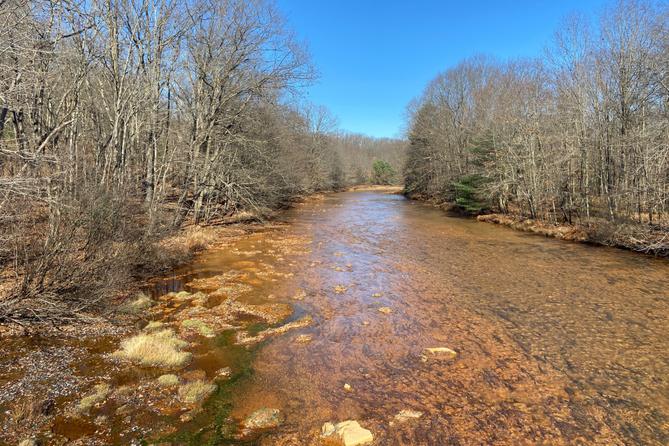This story was produced by the State College regional bureau of Spotlight PA, an independent, nonpartisan newsroom dedicated to investigative and public-service journalism for Pennsylvania. Sign up for our regional newsletter, Talk of the Town.
RUSH TOWNSHIP — As solar developers set their sights on roughly 1,500 acres in rural Rush Township, local elected officials are tasked with figuring out how to welcome the proposed project without hindering efforts to clean up suspected acid mine drainage.
That pollution from abandoned coal mines can clear up without formal reclamation efforts, but that could take decades. In the meantime, acid mine drainage can be harmful to humans and wildlife.
And if developers build a solar array on top of what’s believed to be mine waste in Rush Township — where it’s not unusual for nearby streams to run red or orange from drainage — the township’s supervisors fear future land restoration will be impossible, or, at the very least, force a decadeslong wait for cleaner waterways.
Rush’s supervisors aren’t opposed to the solar industry operating in their Centre County township, which has about 3,700 residents. But they want the developers — Prospect14, a solar company, and Ampliform, a joint venture launched in 2022 — to be mindful of where the solar panels will be installed and how the array is managed after construction.
The township board is now considering how best to regulate large-scale solar projects through local ordinances and zoning changes without shutting down an environmental group already engaged in reclamation efforts. The first step is a public hearing on a proposed zoning ordinance — which will create a new “commercial energy production” district and regulate construction, safety, and removal of the panels — scheduled for Dec. 12 at 3 p.m.
No one has determined who would be responsible for cleaning up any mine waste on the land, and more testing might be required. Reclamation through formal efforts, such as a treatment center, could take years and millions of dollars to complete.
Public grants awarded to a watershed group or a federally funded state program for abandoned mine land projects could also support the initiative if it’s eligible.
“Remediation is the Gordian knot of Pennsylvania’s legacy of coal mining,” Dave Mason, Rush Township solicitor, told Spotlight PA.
Pennsylvania’s history with coal mining dates back to the 1700s, and acid mine drainage from abandoned sites is the No. 1 water pollution issue statewide, according to the state Department of Environmental Protection.
More than 5,000 miles of Pennsylvania streams are affected by runoff — water mixed with heavy metals — from abandoned mines. Contaminated water and soil can look red, orange, or yellow depending on the type of metals present, and the pollution harms wildlife.
Most drainage issues in Pennsylvania predate the 1977 federal Surface Mining Control and Reclamation Act, which created stricter regulations for active mine operators and established a program to support the reclamation of abandoned sites through treatment systems that remove the metals from affected waterways.
Jeff Skousen, a land reclamation expert at West Virginia University, said it is possible to reuse former mining land. Though the soil might not support agriculture, a reclaimed property could sustain trees, pastures, or development projects like solar arrays, he told Spotlight PA.
Mason credited the Moshannon Creek Watershed Association for informing the township supervisors about the severity of acid mine drainage. Had representatives for the group not attended public meetings, it’s likely the township wouldn’t have known about its impact on the area and its waterways, he told Spotlight PA.
The watershed association works to protect and improve its namesake, a 57-mile creek that flows through Centre and Clearfield Counties. It has a 275-square-mile watershed in central Pennsylvania and includes clean waterways with ample outdoor recreation opportunities. But other parts of the watershed are tainted by abandoned coal and clay mines.
In 2021, the organization released a conservation plan for the creek. The report, funded by state grant dollars, outlines projects that would help improve water quality. It also identifies streams that need additional testing or where pollution has worsened, including along Coaldale Road, where developers have proposed the solar array.
Eric Skrivseth, who works with the watershed association, said most of the drainage comes from Clearfield County. He added that Wolf Run, a tributary that flows through the middle of the suggested project site, has the worst water quality in the entire watershed.
The watershed association doesn’t oppose solar power or developing arrays on former mine lands, but it wants to make sure that this development doesn’t interfere with future improvement efforts.
“If you put up panels and you find out after the fact that the middle of where the panels are is where you need a treatment system, then it’s too late to do something about it,” Skrivseth told Spotlight PA.
He added that the group is searching for grants to fund testing of more land samples.
A spokesperson for the developers declined to answer questions about the project, telling Spotlight PA in an email that the companies are working with elected officials, community groups, and businesses as the proposal progresses.
“At this juncture, we are unable to provide detailed information regarding the project as terms and dates can change,” Meghan Gross wrote on behalf of Ampliform. “However, we can confirm that Ampliform representatives will be working in conjunction with all involved stakeholders to ensure that it brings safe and renewable energy to the region in the coming years with 2026 as target date.”
If the watershed group confirms the land contains mine waste, a state-level program for abandoned mine reclamation could help address the issue. The program focuses on land where mining activities predate the 1977 federal law, which made reclamation the responsibility of mine operators after it took effect.
In Pennsylvania, the Bureau of Abandoned Mine Reclamation evaluates sites for eligibility, assessing whether a site was last mined for coal before Aug. 3, 1977, and whether the current property owners benefited from any pre-1977 mining activity.
The DEP couldn’t immediately confirm whether the land in Rush Township would qualify as a pre-1977 abandoned mine, leaving local officials and environmentalists to wait and investigate other potential avenues.
DEP’s projects are prioritized based on protecting public health and restoring land and water resources, agency spokesperson Josslyn Howard told Spotlight PA. The state also considers property owner interest and the ability to obtain environmental clearances and complete construction contracts.
There are 302,869 acres of unreclaimed land statewide, and $5 billion would be needed to restore it, according to the DEP.
SUPPORT THIS JOURNALISM and help us reinvigorate local news in north-central Pennsylvania at spotlightpa.org/donate/statecollege. Spotlight PA is funded by foundations and readers like you who are committed to accountability and public-service journalism that gets results.

